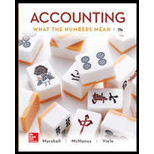
Concept Introduction:
Revenue and Capital Expenditure:
Expenses are categorized in two types for the purpose of recording, Revenue expenses and Capital Expenses. Revenue expenses are day to day operating expenses, whereas the capital expenses are the expenses incurred in acquisition and improvement of assets. The expenses which are incurred in acquisition and improvement of assets are capitalized to the cost of the assets.
Requirement-a:
To Calculate:
The Operating income that should have been reported for the current year
Concept Introduction:
Revenue and Capital Expenditure:
Expenses are categorized in two types for the purpose of recording, Revenue expenses and Capital Expenses. Revenue expenses are day to day operating expenses, whereas the capital expenses are the expenses incurred in acquisition and improvement of assets. The expenses which are incurred in acquisition and improvement of assets are capitalized to the cost of the assets.
Return on Investment (ROI): The return on investment is a profitability ratio that measures the percentage of profit earned on the investment made. It is calculated with the help of following formula:
Requirement-b:
To Calculate:
The ROI using the incorrect and correct net operating income
Concept Introduction:
Revenue and Capital Expenditure:
Expenses are categorized in two types for the purpose of recording, Revenue expenses and Capital Expenses. Revenue expenses are day to day operating expenses, whereas the capital expenses are the expenses incurred in acquisition and improvement of assets. The expenses which are incurred in acquisition and improvement of assets are capitalized to the cost of the assets.
Return on Investment (ROI): The return on investment is a profitability ratio that measures the percentage of profit earned on the investment made. It is calculated with the help of following formula:
Requirement-c:
To Indicate:
The effect of error in future years ROI if not corrected
Trending nowThis is a popular solution!

Chapter 6 Solutions
Accounting: What the Numbers Mean

 AccountingAccountingISBN:9781337272094Author:WARREN, Carl S., Reeve, James M., Duchac, Jonathan E.Publisher:Cengage Learning,
AccountingAccountingISBN:9781337272094Author:WARREN, Carl S., Reeve, James M., Duchac, Jonathan E.Publisher:Cengage Learning, Accounting Information SystemsAccountingISBN:9781337619202Author:Hall, James A.Publisher:Cengage Learning,
Accounting Information SystemsAccountingISBN:9781337619202Author:Hall, James A.Publisher:Cengage Learning, Horngren's Cost Accounting: A Managerial Emphasis...AccountingISBN:9780134475585Author:Srikant M. Datar, Madhav V. RajanPublisher:PEARSON
Horngren's Cost Accounting: A Managerial Emphasis...AccountingISBN:9780134475585Author:Srikant M. Datar, Madhav V. RajanPublisher:PEARSON Intermediate AccountingAccountingISBN:9781259722660Author:J. David Spiceland, Mark W. Nelson, Wayne M ThomasPublisher:McGraw-Hill Education
Intermediate AccountingAccountingISBN:9781259722660Author:J. David Spiceland, Mark W. Nelson, Wayne M ThomasPublisher:McGraw-Hill Education Financial and Managerial AccountingAccountingISBN:9781259726705Author:John J Wild, Ken W. Shaw, Barbara Chiappetta Fundamental Accounting PrinciplesPublisher:McGraw-Hill Education
Financial and Managerial AccountingAccountingISBN:9781259726705Author:John J Wild, Ken W. Shaw, Barbara Chiappetta Fundamental Accounting PrinciplesPublisher:McGraw-Hill Education





